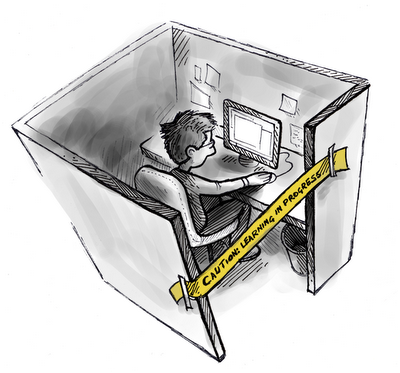Learning 2.0 and the Convenience Factor
Okay, apologies first while we ponder this issue once again…not to slow or accelerate the inevitable penetration of social media to the training function, but more to flush out the worries as well as opportunities we can identify today.
So, how resilient will a century of structured learning be in the light of the unstructured approach of social media? Do we see it as a future replacement for formal training? How? And let’s face it, when? Let’s accept that structuring an informal approach to communication can fast become an oxymoron if we are not careful.
I know, we are starting with questions. And having a lot of questions may be a copout. But these types of questions are a reality right and left for us as our clients grapple with the integration of Web 2.0 in the workplace. When we reach a point where we are asked to incorporate social learning into existing training, the time for questions will be over. For now, we exist in a period of grace where there is much talk but very few actual implementations of Learning 2.0. An attempt to formalize something informal just doesn’t work with the current models we are looking at.
Tom Kuhlmann recently wrote a blog on how to avoid information overload. He gives some great tips on how to navigate through social media and even how to filter it to pull out information you want or need. But what we don’t see written about a lot is how to organizationally scale these processes to organizations.
We would like to offer a new train of thought on this issue. We tend to be a little myopic and see Web 2.0 as a revolution and intrusive—an attack on formal learning. More often than not, training no matter how you package it (including with different technology), goes through an intrusive to conducive and convenient cycle.
Not too long ago, we took learners out of their cubicles and stuck them in a classroom for weeks to train; then we gave that up and instead left learners in their cubicles, trained them online, and stuck a yellow ribbon across their cubicles declaring to all that learning was currently in progress.
When asynchronous learning came around, or when it was reinvented with the medium of Video discs, CD ROMs and elearning (it always existed in workbooks), training made learning a bit more convenient, even as it was originally seen as intrusive to the instructional vitality of classroom training. But it stuck. You could take it on your own time; you could stop and start when you wanted to; you could bookmark your place and pick it up later. We brought in a new level of convenience. And on that continuum, your ability to use a Google search or look for facts (like specs on a new system or reach out to people to get their advice on using that system), we almost jumped up another level on more convenience. Less intrusive training as part of our workday is a reality.
Perhaps we are visiting the same movie with new actors. Social media is totally unstructured, some would say intrusive to our way of training, but, while I’m sure there are corporate reports that show how much time people waste at work updating their Facebook account or responding to their twitter account, what I really want to know is: are these social environments intrusive to the point where we are no longer going through any real process of acquiring knowledge? If we are to learn from the successful adoption of good blends of new technology-based learning over the years, let’s start looking at the convenience factor offered by Web 2.0 in the blend and push that first in training. In looking over some case studies of companies using social media to augment training, the key here is that 1),most of them are using it like a discussion room, and 2), it isn’t replacing their formal learning (note: augment training).
I’m curious as to your thoughts on best practices for implementing social media, whether you think social media will replace formal training, and how can we use it as something for more than just discussion.





